|
|
|
|
|
Understanding High Performance Building through the integration of renewable solar energy
Harsha Shamnani 1
1 Research
Scholar, India
|
|
ABSTRACT |
||
|
High Performance Building is a
future approach for sustainable development, focusing on energy efficiency,
reducing carbon footprint, enhancing user comfort, and promoting a
self-sufficient system. In the current times, where climate change is a major
challenge, shifting to the use of renewable energy, such as solar, is a key
element to achieve net-zero energy goals. This paper will study how the
integration of solar and wind technology can contribute to the efficiency of
buildings, keeping the climate and function in place. Case study: The
Edge and CII Sohrabji Green Godrej Business Centre will explore the
integration of renewable energy and design strategies with active and passive
techniques as architectural approaches. The paper concludes that the
integration of renewable energy is a fundamental need for high-performance
buildings in urban contexts. Aim To study, understand the role and
integration of solar energy in achieving high-performance and
energy-efficient buildings. Objectives 1) To study, identify, and
define key aspects of high-performance buildings 2) To study the integration
of solar energy for building performance 3) To study the building
design strategies for applications of renewable energy 4) To analyse a relevant
case study using solar technology effectively |
|||
|
Received 15 April 2025 Accepted 26 July 2025 Published 04 August 2025 DOI 10.29121/ShodhShreejan.v2.i2.2025.26 Funding: This research
received no specific grant from any funding agency in the public, commercial,
or not-for-profit sectors. Copyright: © 2025 The
Author(s). This work is licensed under a Creative Commons
Attribution 4.0 International License. With the
license CC-BY, authors retain the copyright, allowing anyone to download,
reuse, re-print, modify, distribute, and/or copy their contribution. The work
must be properly attributed to its author.
|
|||
|
Keywords: Solar Energy,
High-Performance Buildings, Net-Zero Energy |
|||
1. INTRODUCTION
The built environment is at the epicentre of the climate crisis, where buildings contribute to global emissions around 28% of carbon dioxide emissions, especially in fast-growing cities. Globally, buildings require around 40% of total final energy consumption for their operational needs over their lifespan. According to the Bureau of Energy Efficiency of India, buildings account for more than 30% of the national energy use and 20% of its carbon emissions NEXT IAS. (2024). India’s urban population is expected to reach 600 million by 2030, and energy demand from buildings will also increase NEXT IAS. (2024).
India aims to achieve net-zero emissions by 2070, increasing the adoption of clean energy to meet growing demands. With buildings consuming around 40% of electricity, integrating Renewable Energy (RE) into the urban system becomes a need of the development. Solar energy in India is the most adequate source to meet the needs of future for power generation TERI. (2025).
A 25-year vision document by the government has planned 85% of the power generation from renewable and green energy sources making India to become one of the main markets for solar energy with huge user base for solar applications Enphase. (2022). Keeping solar as a key renewable energy source, government targets 500GW of non-fossil fuel capacity by 2030 TERI. (2025). The projected capacity addition for solar energy during the period 2027 – 2032 is 179 GW, leading to 365 GW of solar capacity TERI. (2025). India added 10 Gigawatt (GW) of solar energy to its cumulative installed capacity in 2021—the highest 12-month capacity addition, recording nearly a 200% year-on-year growth Enphase. (2022).
The demand in the renewable energy sector and initiatives by the government to meet the future demand, India will play an important role in implementing solar energy in the future. As buildings consume 30% of electricity, BIPV is one of the integrated solution by transforming building materials into energy-generating surfaces, enhancing efficiency, functionality, and reducing fossil fuel dependence TERI. (2025).
In urban areas, limited land availability restricts the rooftop solar solutions from fulfilling the requirements of the occupants. High-rise building provides access to the façade of the building with the scope of an innovative solar integration method. Thus, the journey towards net-zero will be realised with the reduction of carbon emissions intensive sectors, like buildings, to build net-zero buildings for tomorrow. With this, the integration of solar energy into building design with passive and active strategies enables buildings to reduce their carbon footprint and generate their own energy. High Performance Buildings is a strategy to reduce environmental impact, energy efficiency, and generation with occupant well-being.
2. High Performance Building
High Performance Building is a response to the worsening of climate change and huge development. It addresses the essential need of sustainable living, understanding the energy efficiency challenges, climate considerations, with appropriate resource use. Maximizing energy efficiency, minimizing environmental impact with the provision of optimal indoor environment is one of the key aspects of HPB. This is achieved with the integration of active practices - advanced technologies, use of sustainable materials, innovative construction practices, and passive practices at the developmental stage of building. Thus, it will bring quality of life to the occupant, building and responsible relationship with the environment.
2.1. Key features of HPB as follow
1) Integrated Design: It includes all the stakeholders for making appropriate design decisions for any building/structure – engineers, architect, sustainable experts, energy experts. For eg: Space needs 50% of natural lighting along with cooling through air-conditioning.
2) Sustainable Material Choices: It prioritizes energy efficient material with low embodied carbon and high recycled content. Life cycle analysis will help to identify materials with minimal environment impact, low emission materials improving indoor air quality and reducing harmful volatile material. For eg: cross laminated timber and recycled steel both have lower carbon footprint than traditional concrete and steel.
3) Energy Efficiency Strategies: It aims net-zero or net-positive energy performance, generating as much energy as than the building consumes. Use of renewable energy, like solar and wind energy, is prominent for high-performance buildings.
4) Water Conservation: It factors the water through efficient fixtures, rainwater harvesting, and wastewater recycling. For eg: the TERI Campus has rainwater harvesting along with efficient fixtures.
5) Performance Monitoring: It uses advanced monitoring systems to track real time energy use and generation for operational efficiency.
2.2. Advantages of High-Performance Building
It can be understood at 3 aspects – Economic benefits, Environmental Benefits, Social and Health Benefits.
Economic benefits: It saves energy costs of building through the reduction of heating, cooling, and lighting needs of it. Well efficient, performing buildings will have higher property value and lower operational cost.
Environmental Benefits: Use of Renewable energy for HPB decreases greenhouse gas emissions. Optimized water use, energy-efficient system, and use of either recycled or sustainable material reduce resource depletion.
Social and Health Benefits: It minimizes pollutants with the provision of clean, healthy air for the user. Optimized thermal insulation, acoustic controls, and advanced lighting systems make a comfortable living environment.
2.3. Policy and High-Performance Buildings
There are various policies formed globally in different regions focusing on aspects of building and supported by renewable energy to achieve the net-zero target. The key framework is by the IEA (International Energy Association), 2021, published report named Net Zero by 2050: A Roadmap for the Global Energy Sector. This report primarily recommends globally for the building industry to have a mandate for net-zero building codes, empowering energy-efficient retrofits, adaptation of on-site renewable energy as a new norm, Inclusion of smart building systems allowing energy management and encouraging green life cycle of building materials.
At a local level, regional climate goals with building regulations should be integrated. Incentives and financing models should be offered by the government, integrating solar and wind into new or existing buildings. Public buildings should serve as a landmark for such net-zero strategies using solar and wind energy. Raise awareness to educate developers, designers, and strategists about the benefits of net-zero buildings and renewable integration for active participation and acceptance GlobalABC, IEA, & UNEP (2020).
2.3.1. Policy support Worldwide
European Union: The “Green Deal” is a strategy, launched in 2019, for policy initiatives and reaching climate neutrality by 2050 and retrofitting energy-efficient building designs.
Germany: Its Energy Efficiency Strategy 2050 sets out to strengthen its policy. The policy sets the primary reduction of energy consumption by minimum 32.5% by 2030 with required measures in new National Energy Efficiency Action Plan Federal Ministry for Economic Affairs and Energy. (2021) .
KfW Bank is one of the world’s biggest financing institution for energy efficiency and renewable energy with major promotional, protector for climate and environment. This Bank really brought in the required change for Germany in Energy Efficient Construction and Energy Efficient Refurbishment.
Denmark: The government has an energy policy goal – by 2050 energy supply will be solely on renewable energy sources. It has strict building regulations for the construction of new buildings, even though the annual building rate is 1-2% of the total building stock. Therefore, regulating the energy performance of existing buildings plays an important role. The Danish Building Code (BR 18) is one of the main policy to achieve energy savings. It regulates the minimum standards for the energy performance of major renovations of buildings making it more energy efficient State of Green. (2022).
Unites States: To focus on environmental concerns, integrate better buildings with human and nature, LEED certification and Energy Star have become a necessity to include for buildings. Such buildings will have minimal environmental impact and better energy efficiency. The Energy Star program is to identify and promote products that are the most energy efficient. Inclusion of energy-efficient products will bring savings on energy bills of the user and reduce greenhouse gas emissions due to inefficient use of energy GBRI. (n.d.).
LEED certification encourages good building practices to promote sustainability for new and existing buildings. It is the world’s most widely used green building rating system. It provides a structure for highly efficient, healthy, and cost-effective green buildings, which have environmental, social, and governance benefits.
In India, various green policies like GRIHA, ECBC started shaping up around 2007. GRIHA (Green rating for Integrated Habitat Assessment), conceived by TERI (The Energy and Resources Institute) and Ministry of New and Renewable Energy for the national rating system for green buildings.
BEE Star rating: To create stronger energy-efficient buildings, the BEE programme is on the actual performance of a building. It developed ECBC (Energy Conservation Building Code), which provides minimum requirements for the energy-efficient design and construction of buildings. Energy Star-rated buildings in India have better benefits compared to non-star-rated buildings, 40% greater energy efficiency compared to standard buildings, as well as lower operation costs Commercial Design India. (n.d.).
Table1
|
Table 1 Overview of Policies, its Key Aspect and Renewable Support |
|||
|
Policy |
Region |
Key Aspects |
Renewable Support |
|
IEA |
Global |
Net-zero carbon building by 2050 |
Solar and wind Integration |
|
Green Deal |
EU |
Climate neutrality, Building retrofitting |
Solar, wind, BIPV |
|
KfW |
Germany |
Financial support for energy-efficient home |
Solar PV, Wind turbines |
|
BR 18 |
Denmark |
Building energy limits |
Solar PV, Wind |
|
LEED/Energy Star |
US, Global |
Green certification, green products |
Solar PV, Wind, Thermal system |
|
GRIHA |
India |
Sustainable Design |
Solar, Wind, Passive strategies |
|
BEE - ECBC |
India |
Energy Use, Building envelope |
Solar PV, Solar thermal |
Thus, globally, governments are formulating diverse region-specific policies to address climate change and sustainable urbanization. These policies are aligned with climate-responsive, sustainable resource utilization and energy efficiency. A holistic approach is kept in mind from planning to design to execution to operation and retrofitting of the buildings. The effectiveness of the above policies is the integration of renewable energy technologies – solar, wind, and thermal systems. These systems, along with green products, are being integrated with the building and urban projects. Thus, the alignment of policy with technology innovation and environmental goals will shape the new environment, which is energy efficient, inclusive of sustainable development, and climate resilience.
3. CASE STUDY
The need for decarbonization, climate neutrality in the built environment requires high-performance buildings as a model for the construction industry. High-performance buildings are a response to it, integrating energy efficiency, user health with technological innovation. The case study will look into geographic context, climatic context, policy context and the strategies used to shape the efficiency of the building and innovation in its design. It will contribute to a deeper understanding of meeting global energy goals.
3.1. The Edge, Amsterdam, Netherlands
The Edge, designed by PLP Architecture and developed by OVG Real Estate, is Deloitte’s headquarters building with has 15-storey atrium. It is located in Amsterdam’s Zuidas business district.
Year: 2015
Area: 40000 sq.mt
Typology: Office Building
BREEAM rating: 98.36% (Green Building Sustainability rating system)
Concept:
The brief was to design an inspirational business environment and set new standards for office design in areas of sustainability, technology, workplace, structural, and façade engineering. To create a ‘smart building' which be a catalyst for the company's transition to the digital age. It interacts with the city through a huge 15-story atrium. It becomes a window between the world of work and the outside, and a social heart for the building Li (2024).
Figure 1

|
Figure 1 Exterior View of the Building Showcasing the Atrium as the Core Element Source The
Edge_Paper_LOW |
Key Features:
Form Development of the building
Figure 2

|
Figure 2 Depicts the Form Generation of the Building with a Fundamental Cube |
Figure 3

|
Figure 3 Depicts
the Relationship Between Heat Gain and the Form of the Building Source The
Edge, PLP Architecture |
Figure 4

|
Figure 4 Exterior View Showcasing the Lightness of the Building Source The Edge, PLP
Architecture |
The above atrium façade filters north light through the low-e glass. As a continuous surface, this façade unfolds into the roof to bring dynamicness with the frame of surrounding to the inside. The skin acts as a threshold between the outside and inside.
Building Orientation
Shape and Orientation of the building is the first step to achieve climatic and energy performance. It is designed to take maximum advantage of the sun throughout the year. The arrangement of large floor plates around 15-storey atrium, which faces towards the north, allows natural daylight to the office spaces. The load-bearing structure and smaller glazed opening facing south provide thermal mass. Thus, atrium becomes the core of the building, ventilating the office space and a buffer with the exterior which reduces energy consumption in summer and winter PLP Architecture. (2015).
Figure 5

|
Figure 5 Cross-Section
of the Building Highlighting the Key Features of the Building Source
Archinspires, Case Study: Sustainable Features of The Edge in Amsterdam
August 12, 2024 |
The south-facing façade brings 6000 sq.mt of solar array, which provides the energy needs of the building. The building is built over a groundwater aquifer, allowing to manage warm and cold water with the help of thermal energy storage pumps. IoT sensors track water as well as local climate conditions. Energy efficient design, green energy–generating technology, it captures rainwater and stores it underground for the use of watering plants in the interior and exterior gardens and flushing toilets PLP Architecture. (2015).
Atrium:
Figure 6

|
Figure 6 Interior
view of 15-Storey Atrium Showcasing Access to Natural Resources and Work Culture Source Archinspires,
Case Study: Sustainable Features of The Edge in Amsterdam August 12, 2024 |
The atrium is the lung of the building, a strong identity to the building. It is the “gravitational centre of its solar system”. Cross natural ventilation is planned with the help of mesh panels between each floor, allowing stale air to spill into the open space and rise through the roof. Natural weather changes like temperature change, air flow change, a rainy day, or lightning, a building creates an outdoor-like ambiance with natural light and glass angles. It has a slanted roof that loads workspaces with natural light and acts as a sound barrier from nearby roads Li (2024).
Use of Sunlight:
Figure 7
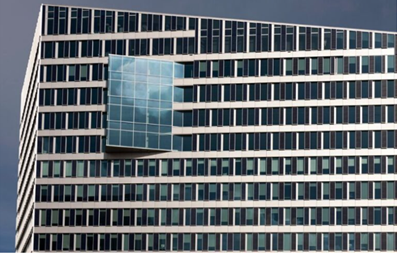
|
Figure 7 Exterior
View Showing the Arrangement of Solar Panel and Glass as a Grid Source
Archinspires, Case Study: Sustainable Features of The Edge in Amsterdam
August 12, 2024 |
The southern wall of the building has a checkerboard design of solar panels and windows. This describes the maximised use of sunlight and making it effective for sustainability. This contributes to the building consuming less 70% electricity than the office building Li (2024). Thick load-bearing concrete helps to control the building’s temperature, and recessed windows minimize the need for shades, even with direct sunlight. The roof has solar panels as well. The designer also added solar panels on the rooftops of the university buildings to generate more energy than it requires. The building has 1920 sq.mt of solar panels, while 2280 sq.mt of solar panels are on the rooftops of other university buildings, making it a net-zero building Jalia, Bakker, & Ramage (2018).
Integration with the Internet of Things
It has around 30,000 IoT sensors, gathering information on various activities within the building – lighting, heating and cooling systems, room occupancy, printer, and beverage machines. This is designed to optimize energy consumption, performance, user comfort as temperature, CO2 levels, humidity, and productivity. This makes building consume around 30% of the energy for an office.
Additionally, it allows employees to identify parking space, reserve desk, report issue to facilities management, and check their own energy usage in the building Li (2024).
Thus, with the integration of active and passive strategies, technology for building design, it is estimated to the reduction of 42 million kg of CO2 on the environment over the span of a decade, making remarkable energy savings Jalia, Bakker, & Ramage (2018).
3.2. CII, SOHRABJI GREEN GODREJ BUSINESS CENTRE, HYDERABAD
It is India’s first LEED Platinum rated building from 2004. It is a commercial and institutional building that uses traditional Indian concepts and modern green building practices. It is a centre of excellence for CII (Confederation of Indian Industry) energy efficiency, green building, renewable energy, and sustainability activities. The key features include Solar PV systems, high-efficiency HVAC systems, high-performance glass, aesthetic roof gardens, natural ventilation through building form and wind tower, rainwater harvesting, and green spaces. Thus, the building boasts 50% savings in overall energy consumption, 35% reduction in potable water consumption and usage of 80% of recycled material Rathod (2019).
Site area: 4.5 acres
Built-up area: 20000 sq. ft
Building footprint: 9.2% of the site
Figure 8
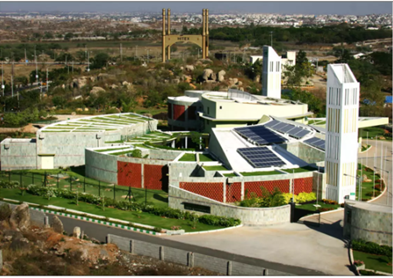
|
Figure 8 Overall
Site View and Immediate Surroundings, 2004 Source CII Sohrabji
Godrej |
Figure 9
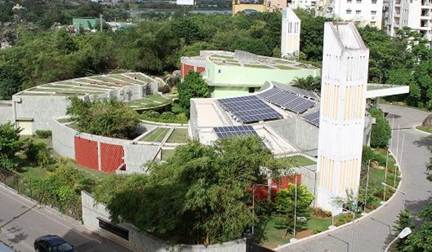
|
Figure 9 Overall
Site View and Immediate Surroundings, 2024 Source CII Sohrabji
Godrej |
Site as a Context:
Figure 10

|
Figure 10 Schematic Layout Showing the
Integration of Topography and Building Source Rathod, P. (2019). Architectural Appraisal – CII- Sohrabji Godrej
Green Business Centre Hyderabad [Slide presentation]. SlideShare |
The site is covered with dense vegetation and various species of birds and animals. Site planning is done to minimize site damage and environmental impact. More than 70% of the site contour and its landscape is retained as a surface. The landscape is home to more than 600 varieties of trees, which are native to local climatic conditions. The site is flat on the southwest side, plateau on the east side, and a water body on the northern side.
Site as a Resource:
Air Pollution as a Design Parameter
Figure 11
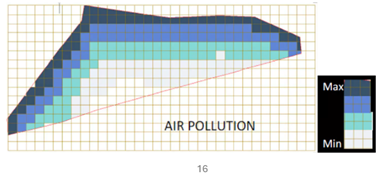
|
Figure 11 Showing
the Presence of air on the Site Source Rathod, P.
(2019). Architectural Appraisal – CII- Sohrabji Godrej Green Business Centre
Hyderabad [Slide presentation]. SlideShare. |
Noise Pollution as a Design Parameter
Figure 12
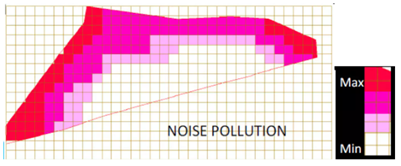
|
Figure 12 Showing the Accessibility of Noise in the Site Source Rathod, P.
(2019). Architectural Appraisal – CII- Sohrabji Godrej Green Business Centre
Hyderabad [Slide presentation]. SlideShare. |
Use of Natural contour for rainwater harvesting
Figure 13

|
Figure 13 Showing the Integration of Site
Contour for Design Ideas Source Rathod, P.
(2019). Architectural Appraisal – CII- Sohrabji Godrej Green Business Centre
Hyderabad [Slide presentation]. SlideShare. |
Orientation/Form:
The building is circular in shape and placed in a manner where air, noise, views, and sun are well integrated as a form derivative. It allows the wind to circulate around and through the building. The wind passing over the water pools and planted area is used for evaporative cooling. The circular form allows the optimum solar gain as 25% less exterior surface area get exposed to weather and heat loss.
Figure 14
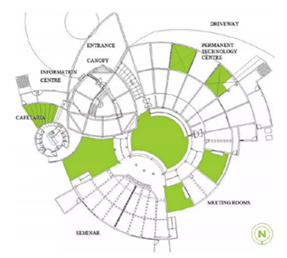
|
Figure 14 Plan Showing
the Green areas in the Building Source Rathod, P. (2019). Architectural
Appraisal – CII- Sohrabji Godrej Green Business Centre Hyderabad [Slide
presentation]. SlideShare |
The circular form provides good strength and security for any kind of disaster, which makes it 10 times stronger than the conventional cuboid form. The circular form brings 25% more square footage than a cuboid building with the use of the same quantity of materials JnaneshPreethan. (2023).
Internal Courtyard:
The central internal courtyard is an energy centre that binds different functions of the building as one entity. Planned small green pockets act as a thermostat, giving protection from weather and allowing visual and physical closeness to nature. This brings various views and vistas to the user.
Figure 15
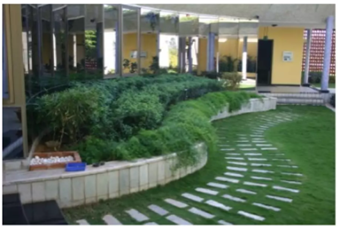
|
Figure 15 Showing the Courtyard Open on One Side Source Rathod, P.
(2019). Architectural Appraisal – CII- Sohrabji Godrej Green Business Centre
Hyderabad [Slide 12]. SlideShare |
It is acting as a light well, which provides the required illumination to work areas. When the natural light is not sufficient, then sensors trigger for efficient electric lights. Dimmers control the illumination levels, turning the light offs when they are not required. Occupancy sensors prevent a light from being switched on at unoccupied workstations. The natural light from the courtyard integrated with energy efficient lighting system, saves 88% higher electricity than any same size building. Most of the building have daylight access and views to the outside and nature.
Figure 16
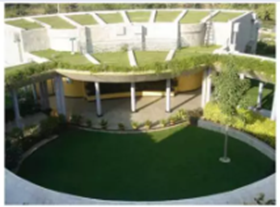
|
Figure 16 Showing the Internal Courtyard of the Building |
Figure 17
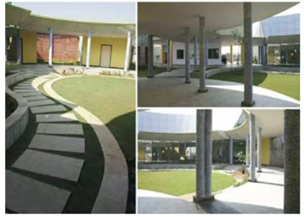
|
Figure 17 Showing
the Views of the Courtyard as a Lightwell Source
Jhunjhunwala, G. (2014). Sohrabji Godrej Green Business Centre [Slide
presentation]. SlideShare. |
JALI AS A SCREEN:
Figure 18
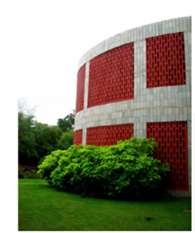
|
Figure 18 Showing the Jali Wall as an Aesthetic Element of Light and Shadow |
Figure 19
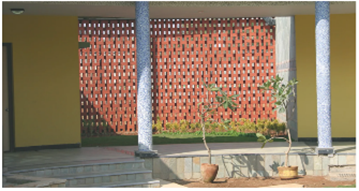
|
Figure 19 Showing the use of Brick Jali Wall as a Façade for Natural Ventilation Source Rethinking
the Future. (n.d.). CII-Sohrabji Godrej Green Business Centre by Karan Grover
and Associates – First LEED Platinum Certified Building in India |
It is one of the traditional Indian elements used as an efficient source of ventilation and daylight. It provides beautiful aesthetics with various patterns and its shadow. Shading from trees on the Jali reduces the heat through the walls. Jali wall increases the surface area and mass of the façade to cool down the breeze in the passage. Thus, it provides controlled air and light to the space, making a comfortable space, with aesthetic of light and shadow on the floor, and an apt choice to expensive window construction. During the rains, water seeps through the punctures of the pattern, becomes a resource for plants.
Figure 20
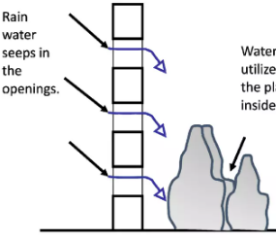
|
Figure 20 Showing
the Typical Section of the Jali for the Water seep Source: Rethinking The Future. (n.d.). CII-Sohrabji
Godrej Green Business Centre by Karan Grover and Associates – First LEED
Platinum Certified Building in India |
Construction and Materials
Energy and pollution are reduced with the help of making choices of the materials and their production and transportation cost. Most of the material was sourced locally within 500 miles from the site. As the site is huge, topsoil erosion and sedimentation control measures were considered during construction. More than 50% of the construction waste was recycled within the building or sent to other sites and not to landfills.
A huge percentage (77%) of the building materials use recycled components in the form of fly ash bricks, broken glass, broken tiles, recycled aluminium, and recycled paper. Use of aerated concrete blocks for the façade reduces the air conditioning load by 15-20% Agrawal (2024). Expanding into the interiors, the use of Bagasse as a board and an alternative to plywood. Use of low volatile organic compound (VOC) paints and coatings, adhesives, sealants, and carpets to improve indoor air quality.
Figure 16
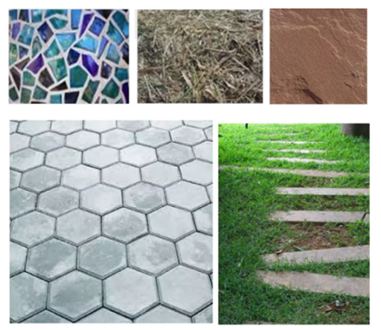
|
Figure 21 Showing the use of Repurposed Material 1. Glass 2. Bagasse 3. Stone 4. Paver block 5. Flat slabs Source Rathod, P.
(2019). Architectural Appraisal – CII- Sohrabji Godrej Green Business Centre
Hyderabad [Slides 27–28]. SlideShare |
3.3. Construction stone waste in paving
The building reuses material from other construction sites like Toilet doors, interlocking pavement doors, stone slab, scrap steel, scrap glazed tiles, and shuttering material.
Water as a Resource:
Rainwater Harvest:
The use of the existing landscape and terrain of the site allows the water flow to collect at a lower level of the site and be harvested through traditional methods. Permeable grid pavers used for pathways and landscape allow rainwater to enter the soil. The use of low-flush toilets and waterless urinals in the building results in a 35% reduction of municipally supplied water.
Waste water Treatment:
The root zone method is used for wastewater treatment. The landscape of the site is used to create wetlands, which comprise clay or plastic-lined excavation and vegetation grows on a gravel or sand mixture. This low-cost and low-energy method enhances the landscape, and irrigates the vegetation, with ease of maintenance.
Figure 22

|
Figure 22 Sketch Showing the Wastewater Treatment through Root Zone
Treatment Source Rathod, P.
(2019). Architectural Appraisal – CII- Sohrabji Godrej Green Business Centre
Hyderabad [Slide 44]. SlideShare |
Roof garden:
It is a design element integrated as radiating as of a circular building form, which absorbs the direct heat of the building. It covers almost 55% of the roof area making it very strong and active design element JnaneshPreethan. (2023).
Figure 23
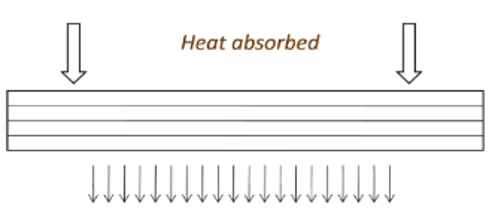
|
Figure 23 Showing Reduction of Heat Absorption through use of Roof Gardens Source Rathod, P.
(2019). Architectural Appraisal – CII- Sohrabji Godrej Green Business Centre
Hyderabad [Slide 24]. SlideShare |
Wind Catcher:
Figure 24
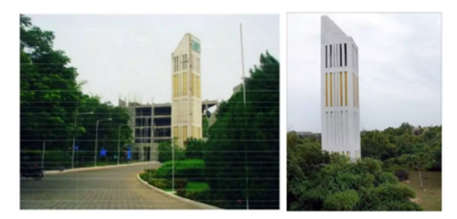
|
Figure 24 Showing the Wind Catcher as an Element for Natural Ventilation Source
JnaneshPreethan. (2023, July 15). CII-Sohrabji Godrej Green Business Centre
[Slide 40]. SlideShare. |
It is an architectural element that creates natural ventilation in the building, making it more energy efficient and sustainable. For the performance of the wind tower, opening on all four sides is provided. The heat transfer rate depends on the surface area with which the air comes in contact. Surface area is increased by having vertical conduits, giving less resistance to air flow. To achieve evaporative cooling, sprinklers are integrated for better effectiveness of the tower.
Figure 25
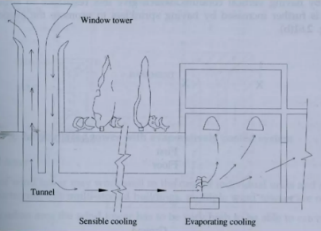
|
Figure 25 Showing
the Natural Ventilation Through Wind Tower and Evaporative Cooling Source
JnaneshPreethan. (2023, July 15). CII-Sohrabji Godrej Green Business Centre
[Slide 38]. SlideShare. |
Figure 26
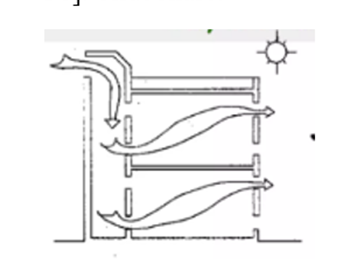
|
Figure 26 Showing the Functioning of a Wind Tower During the Daytime Source
JnaneshPreethan. (2023, July 15). CII-Sohrabji Godrej Green Business Centre
[Slide 39]. SlideShare |
The hot air enters the tower through the opening in the tower and is cooled, when it comes in contact with the cool tower and becomes heavier. Provision of inlet and outlet opening on the opposite side in the space, creates the draft of cool air. Thus, this makes wind tower warm in the evening.
Figure 27
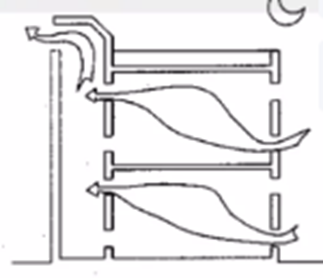
|
Figure 27 Showing
the Functioning of a Wind Tower During the Nighttime Source
JnaneshPreethan. (2023, July 15). CII-Sohrabji Godrej Green Business Centre
[Slide 39]. SlideShare. |
During this time, reverse happens due to warm surface of wind tower and drop in temperature of air, warm air rises upwards. Due to this, cool air enters in the space from the opposite side placed window. With this process, the tower losses the heat that was collected during the daytime and becomes ready for the cold condition in the morning.
Thus, the efficiency and performance of well-designed wind tower allows Air cooled upto 8 0C which is supplied to the AHU and reduces the load on Air-conditioning system JnaneshPreethan. (2023). Along with this, insulated roof further adds to the reduction in cooling load.
Solar Energy
Solar panels are integrated on the roof facing south and west of the terrace, capturing maximum heat. It generates an average of 100-125 units per day. Its installed capacity is of 24KW. The harvested energy through solar panels fulfils around 20% of the energy requirement Jhunjhunwala, G. (2014).
Figure 28

|
Figure 28 Showing the Application of Solar Panels on the Roof of the Building Source JnaneshPreethan.
(2023, July 15). CII-Sohrabji Godrej Green Business Centre [Slide 45].
SlideShare. |
Current development of the building:
Figure 29
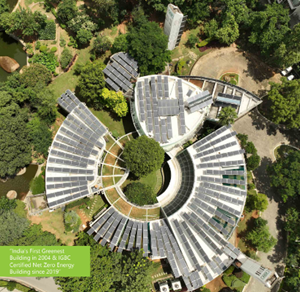
|
Figure 29 Showing
the Building as a Net Zero Energy Building Source Confederation
of Indian Industry (CII). (2025, January 8). CII 20 Years 8th JAN 2025
Approval [Slide 16]. Indian Green Building Council |
Understanding the site as a context, the use of active and passive strategies for wind, water, sun, terrain form, materials, along with technological interventions, makes this building as Net Zero Energy building since 2019.
Observations and Inferences
Table 2
|
Table 2 Key Observations of the Case study – The Edge and CII |
||
|
Parameters |
The Edge, Netherlands |
CII – Sohrabji Green Godrej Business Centre |
|
About: Area, Typology, Year, Height of the
building |
40,000 sq.mt, Office Building, 2015, G+14
storey |
20000 sq. ft, Office Building, 2004, G+1 storey |
|
Recognition |
BREEAM rating: 98.36% (one of the highest in the
world) Smart Building |
India’s 1st LEED Platinum Rated |
|
Sustainable Strategies |
1)Form development in response to climate and
energy efficiency 2)Use of thermal energy storage pumps as the
building is built over a groundwater aquifer 3)Active strategy – South wall as a solar wall
and rooftop solar PV, harvesting solar energy. 4)Atrium as a key element allowing efficient air
circulation, diffused light, and the heart of the building 5)Use of materials allowing light to be part of
space, high-performance glass 5)Use of IoT sensors for monitoring all the
activities to optimize energy consumption, user comfort, and productivity. This makes it possible to consume 30% of the
energy. |
1)Form placement and development in response to
landscape, air flow, solar heat, views, and vistas. 2)Use of Green roofs, open green spaces, and Jali
walls, to respond to the climate 3) Active strategy – Rooftop integration of solar
PV for harvesting it. 4)Use of wind towers to integrate natural air
circulation in the building along with energy efficiency 5)Use of Recycled materials, high-performance
glass, high-efficiency HVAC system to optimize energy consumption |
|
Environmental Benefits |
Reduction of 42 million kg of CO2 on the
environment over a decade, with remarkable energy savings. 70% reduction in the energy consumption of the
building |
Reduction of 50% savings in energy consumption,
35% in potable water consumption |
|
Building Performance |
Net-positive energy building |
IGBC - Net Zero Energy Building 2019 |
4. Conclusion
Climate change is a challenge to the existing threat of ecosystems, cities, lifestyles, the built environment, and the speed of resource depletion. High-performance Buildings (HPBs) is a response to such climate action as global sustainability goals. These buildings go beyond the traditional buildings to achieve net-zero emissions from cradle to grave, reduce carbon footprints, and improve user well-being. It provides the framework for energy efficiency, environmental responsibility with a goal of net-zero energy consumption and supporting climate-resilient urban development.
This paper explored how the integration of renewable energy technologies – solar and wind, along with contextual design strategies, can make buildings a self-efficient system, that is technologically advanced and environmentally responsive.
The Edge (Amsterdam) building sets a benchmark for smart buildings using cutting-edge technology, through the use of rooftop and BIPV solar PV, smart sensors, and an intelligent energy sharing network to reduce its environmental impact. Use of intelligent digital infrastructure cuts down 30% energy consumption of the building. BIPV and Rooftop solar PV make it a net-positive energy building. Overall, a 70% reduction in the energy consumption of the building is an achievement.
CII Sohrabji Godrej Green Business Centre (Hyderabad) is a strong response to the site context, climate–sensitive approach focuses on passive design strategies – optimum orientation, natural ventilation through the form of the building and wind tower, thermal comfort through the use of green roofs, rainwater harvesting through the use of landscape, daylight harvesting through rooftop solar PV and use of recycled materials. This approach leads to a 50% savings in energy consumption. Also, it cuts down 30% of water consumption from the municipality. From 2019 onwards, it is net-zero energy consumption building.
Both buildings have diverse approaches – 1st building is vertically spread (technology-centric), while 2nd building is horizontally spread (climate-responsive), achieving high performance building.
There is a huge potential for the growth of high-performance building. There is a substantial gap in the performance of efficiency, long-term cost reduction to traditional office buildings. Initial cost and investment may be higher, but the benefits are seen over time. The smart buildings can cost about a third to half as much as similar conventional buildings. Including a few of the smart systems can enhance the efficiency of the building to traditional buildings.
This building brought a good strategic understanding of the user for its space. It has provided desk space for 1100 employees over 3000, with a clear need for a desk for part of their workday Li (2024). Such a strategy helps in investing in quality space, which enhances user wellbeing and its productivity to cost savings and people retention. Thus, smart and high-performance buildings play a very important role in building a better wellbeing of people and society.
Integration of Technology is not only about renewable energy generation, but it extends into energy-efficient HVAC, high-performing facade materials, building automation systems, and data-driven energy monitoring. These systems create living systems responding to real-time environment and user needs, improving energy performance and reducing operational cost. Thus, an inter-disciplinary approach needs to be integrated in building design for efficiency and comfort.
The policy framework also plays an important role in the scaling up of HPB. Global standards such as LEED, BREEAM, GRIHA, and government-supported programs like ECBC, KfW incentive, and the EU’s Green Deal have standards for pushing the boundaries of sustainable efficiency. These certifications not only look into efficiency numbers but also inculcate an approach of environmental responsibility within the construction industry. To bring bigger adoption, policies need to go beyond certifications. It should have education and awareness building, financial incentives, renewable energy subsidies, technology awareness, zoning benefits, and strict enforcement at all levels of the construction ecosystem.
Thus, high-performance buildings are the need of the hour for sustainable urban development. Its success depends on technological intelligence, climate-sensitive design, supportive policy infrastructure, and human-centered design. The future of the building industry should include such innovations as a standard solution to carbon-neutral, renewable energy secure, and sustainable urban living environments.
CONFLICT OF INTERESTS
None.
ACKNOWLEDGMENTS
None.
REFERENCES
Commercial Design India. (n.d.). A summary of all the Indian Rating Systems for Green buildings. Retrieved May 15, 2025.
Confederation of Indian Industry (CII). (2025). CII 20 years 8th JAN 2025 Approval [PDF Document]. Indian Green Building Council.
Enphase. (2022). India's Solar Energy Sector: Challenges, Opportunities and the Way Forward.
Federal Ministry for Economic Affairs and Energy. (2021). Germany’s Energy Efficiency strategy 2050.
GBRI. (n.d.). What is the Difference Between Energy Star and LEED?* Retrieved May 15, 2025
Global Alliance for Buildings and Construction (GlobalABC), International Energy Agency (IEA), & United Nations Environment Programme (UNEP). (2020). Globalabc Roadmap for Buildings and Construction 2020–2050: Towards a Zero-Emission, Efficient and Resilient Buildings and Construction Sector.
Jhunjhunwala, G. (2014). Sohrabji Godrej Green Business Centre [Slide presentation]. SlideShare.
JnaneshPreethan. (2023). CII-Sohrabji Godrej Green Business Centre [Slide presentation]. SlideShare.
Li, Z. (2024). Case study: Sustainable Features of The Edge in Amsterdam. ArchInspires.
NEXT IAS. (2024). High Performance Buildings (HPBs).
PLP Architecture. (2015). The Edge / PLP Architecture. ArchDaily.
Rathod, P. (2019). Architectural Appraisal – CII- Sohrabji Godrej Green Business Centre Hyderabad [Slide 3]. The Indian Institute of Architects, Mumbai. Retrieved May 15, 2025.
Rethinking The Future. (n.d.). CII-Sohrabji Godrej Green Business Centre by Karan Grover and Associates – First LEED Platinum Certified Building in India.
State of Green. (2022). Regulating energy efficiency in buildings.
TERI. (2025). WSDS 2025: Thematic track on Advancing Building Integrated Photovoltaics (BIPV) manufacturing in India. The Energy and Resources Institute.
|
|
 This work is licensed under a: Creative Commons Attribution 4.0 International License
This work is licensed under a: Creative Commons Attribution 4.0 International License
© ShodhShreejan 2025. All Rights Reserved.